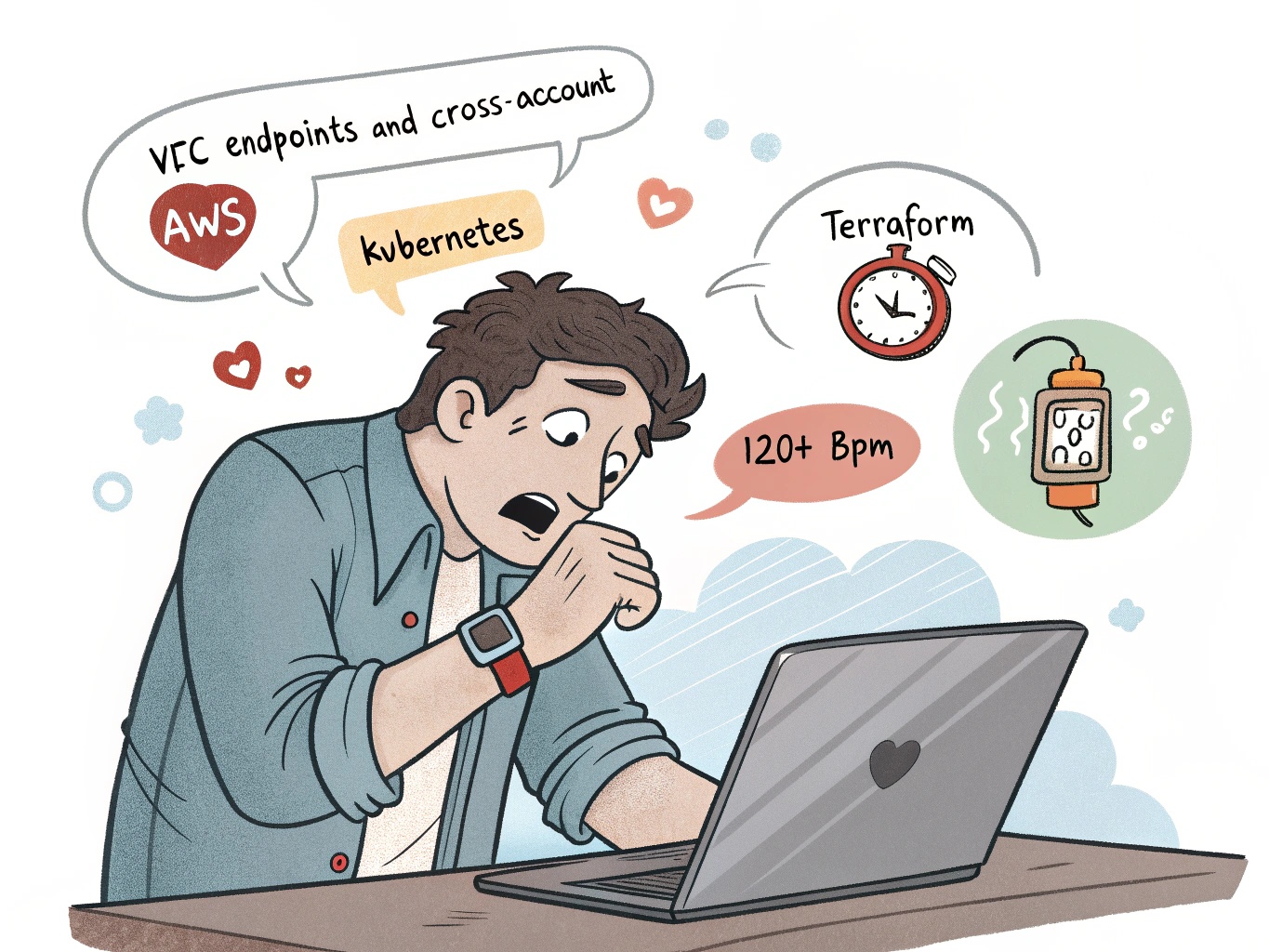During an Interview as a Senior Devops, My Apple Watch said “Buzz buzz, your hearts racing! Are you OK? Should I text your son and wife ?”
The interview might have been successful and I might continue the process, I might have been correct for an important security question that they claimed I was mistaken! I definitely got tongue tied on a few terms, I bet you also get confused about the different AWS endpoints and gateways! Overall, the interviewers were very clear in their questions.

Even after 20+ years in infrastructure, I found myself tongue-tied on topics I work with daily, perhaps because I do them in Terraform instead of the UI. If you’ve been there too, here’s my light-hearted guide to common AWS DevOps interview brain-freezes and the answer for you to know after you hang up, like I did:
AWS Security Misconceptions
The freeze: “How would you ensure encryption between EKS and other AWS services?”
[Brain and mouth confidently says “it’s encrypted by default” but interviewer shakes head NO]
The truth is, “Within a single AWS account, traffic between EKS and AWS services is generally encrypted by default when using AWS’s internal network. However, for cross-account scenarios, you should implement additional security measures like a service mesh solution such as Istio for mutual TLS, or use AWS PrivateLink with proper encryption configurations to ensure end-to-end encryption across account boundaries.”

When faced with conflicting technical information in an interview, a balanced approach helps: acknowledge their perspective while tactfully presenting your understanding. Sometimes the most challenging part isn’t recalling technical details, but navigating when your knowledge conflicts with the interviewer’s expectations! You might get extra points if you clearly state that they are wrong and you right and shortly prove it, might seal getting the job if the job description includes tech leadership! It might also call for a pre-mature end to the interview followed by “we are persuiing other candidates” rejection letter.
AWS Networking Amnesia
The freeze: “So how would you set up VPC endpoints for cross-account access?”
[Brain suddenly forgets what AWS even stands for …]
The recovery: Take a breath and start with what you know: “Let me break this down systematically. I’d first establish the VPC endpoint in Account A, then configure the appropriate resource policies to allow specific principals from Account B to access it. For private endpoints, I’d ensure DNS resolution is properly configured across accounts.” Starting with the basic flow often helps your memory kick in. Also Gateways do the job sometimes. This really bothered me as I listened to a bunch of aws lectures recently but didn’t experiment on my own accounts….. maybe next week since I thought I knew it properly. I have gotten tongue tied about this before.
Terraform Resource Blank-outs
The freeze: “What is the smallest object in Terraform?”
[Brain frantically searches for the word “resource” but finds only black walls instead of doors]
The recovery: Start with what you know: “In Terraform’s hierarchy, we have modules containing multiple… ah, resources! Resources are the fundamental building blocks that represent infrastructure objects like EC2 instances or S3 buckets. The syntax is ‘resource “type” “name” { properties }’.” Sometimes working through the mental model helps you find that one word hiding in your brain! For added confusion I also forgot the word “Provider”, won’t do that again. So you don’t forget it in your real life code, be sure to use the terraform plugin for VS code. This works in the office but does NOT get you the ID card to enter the actual office.
IAM Permission Puzzles
The freeze: “Explain cross-account role assumption…”
[Identity crisis intensifies and imposter syndrome]
The recovery: Use the principle-first approach: “This follows a trust relationship model. In the target account, I’d create a role with a trust policy that explicitly names the principal from the source account. Then in the source account, I’d grant the sts permission to the appropriate users or roles. The actual assumption happens via the STS service using temporary credentials.” Starting with the relationship model helps the technical details fall into place. Of course I didn’t even think about sts assume roles, even though I have done it both in the UI and coded it in various ways many times!
The reality is we all get tongue-tied sometimes. In our day-to-day work, we consult documentation and take time to design thoughtful solutions. The interview hot seat just makes it harder to access that knowledge!
Fellow DevOps engineers: What interview “tongue-tier” moments have you experienced, and how did you recover? Let’s normalize these moments and share our strategies!

